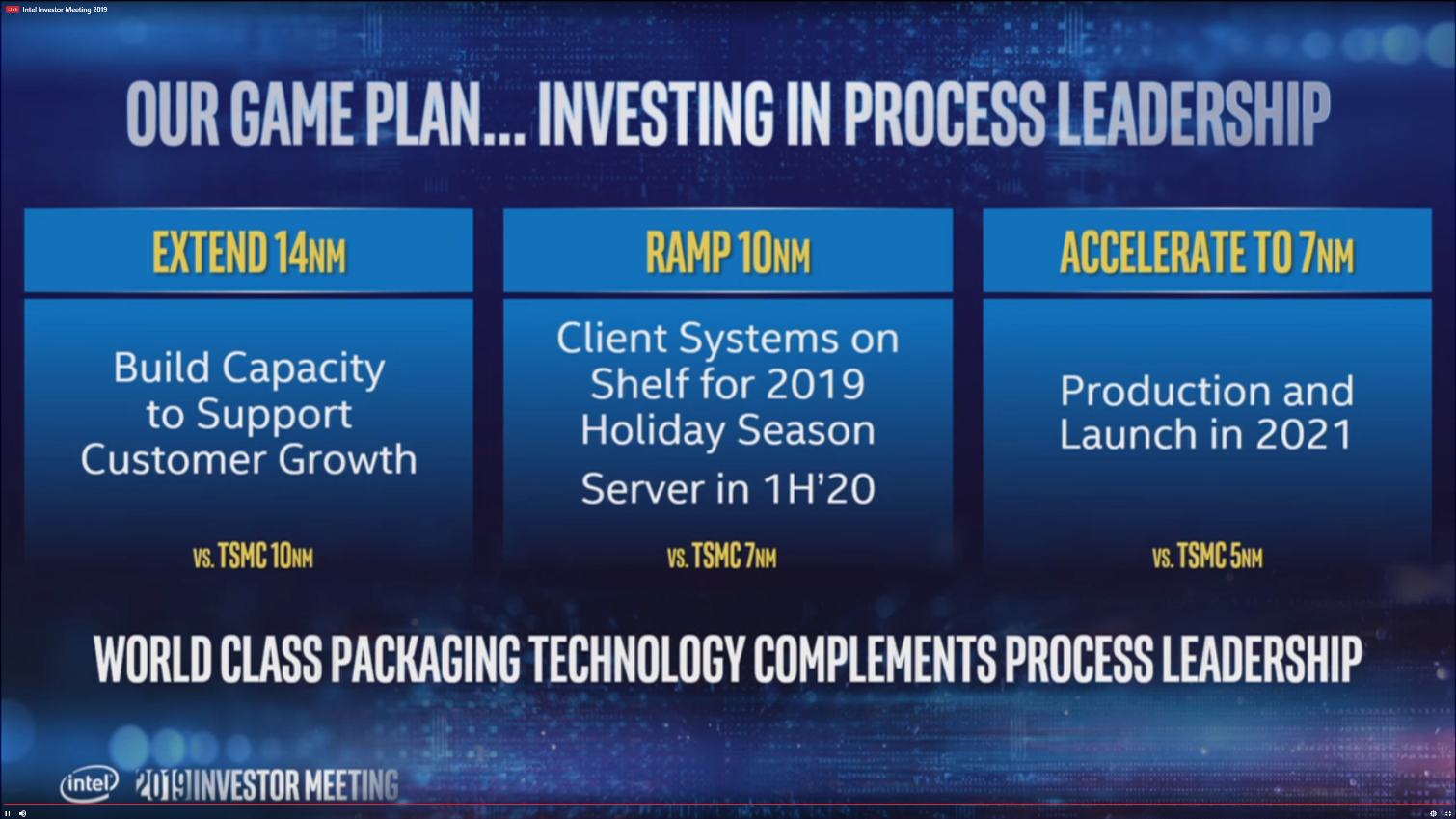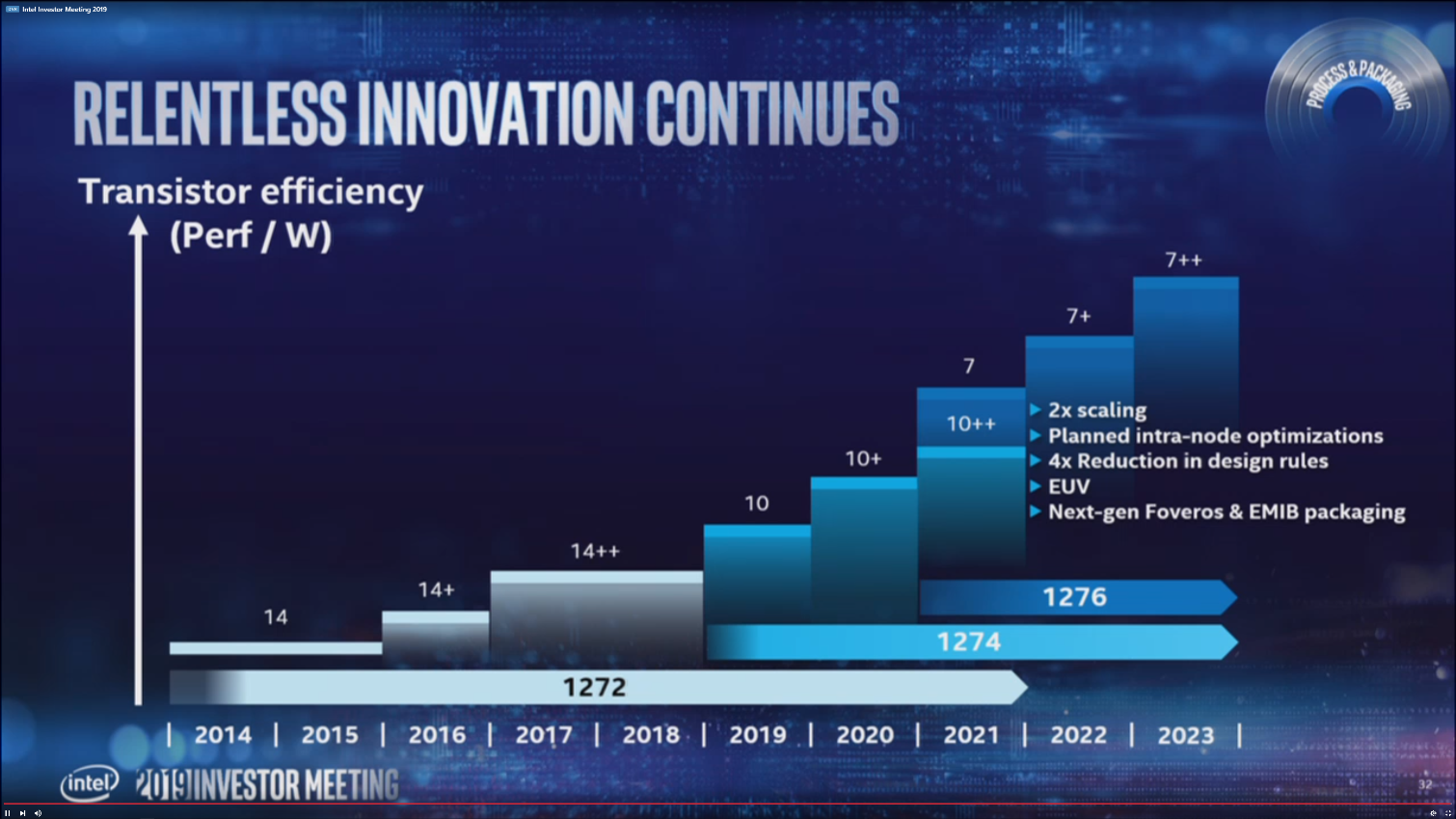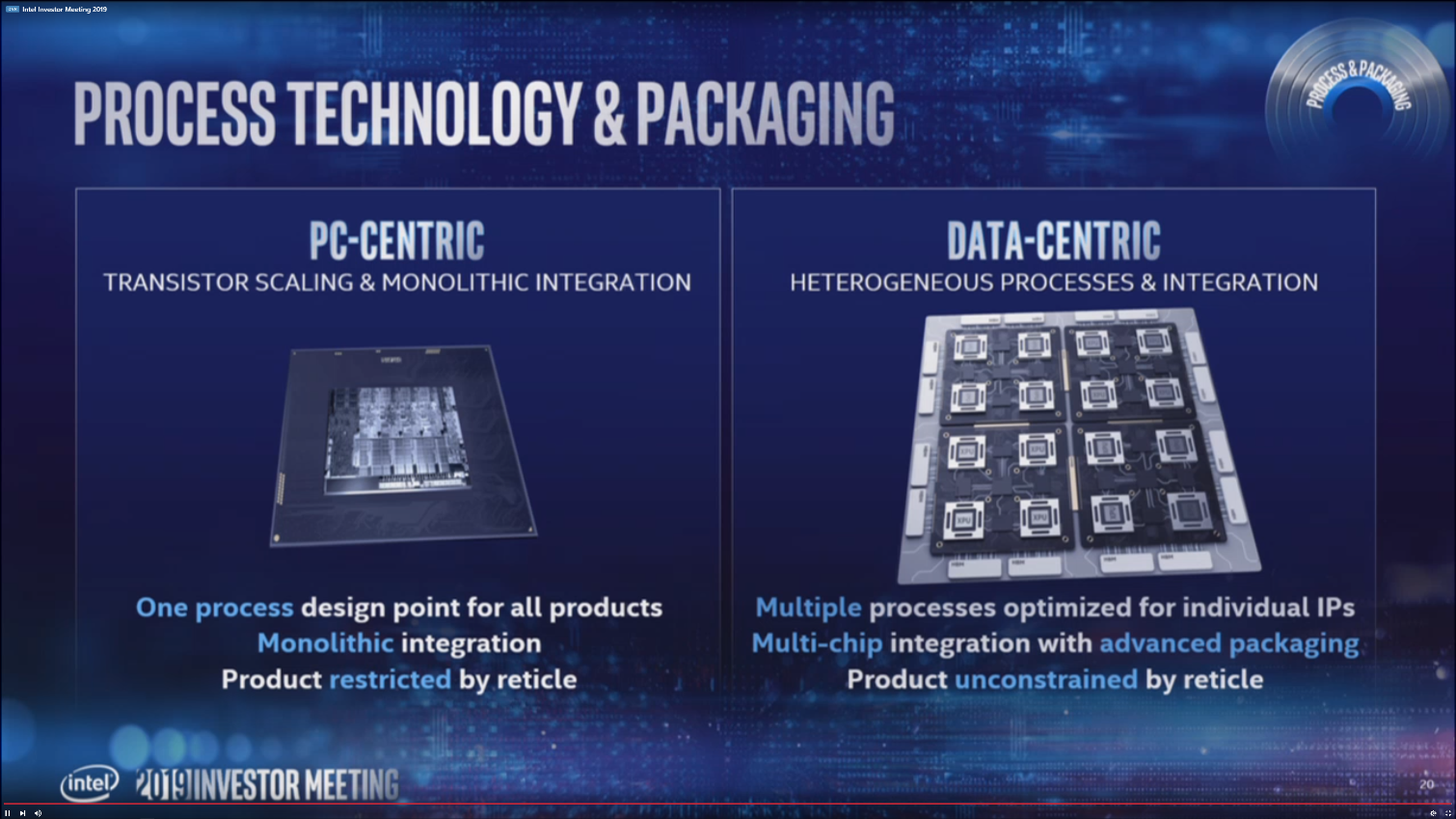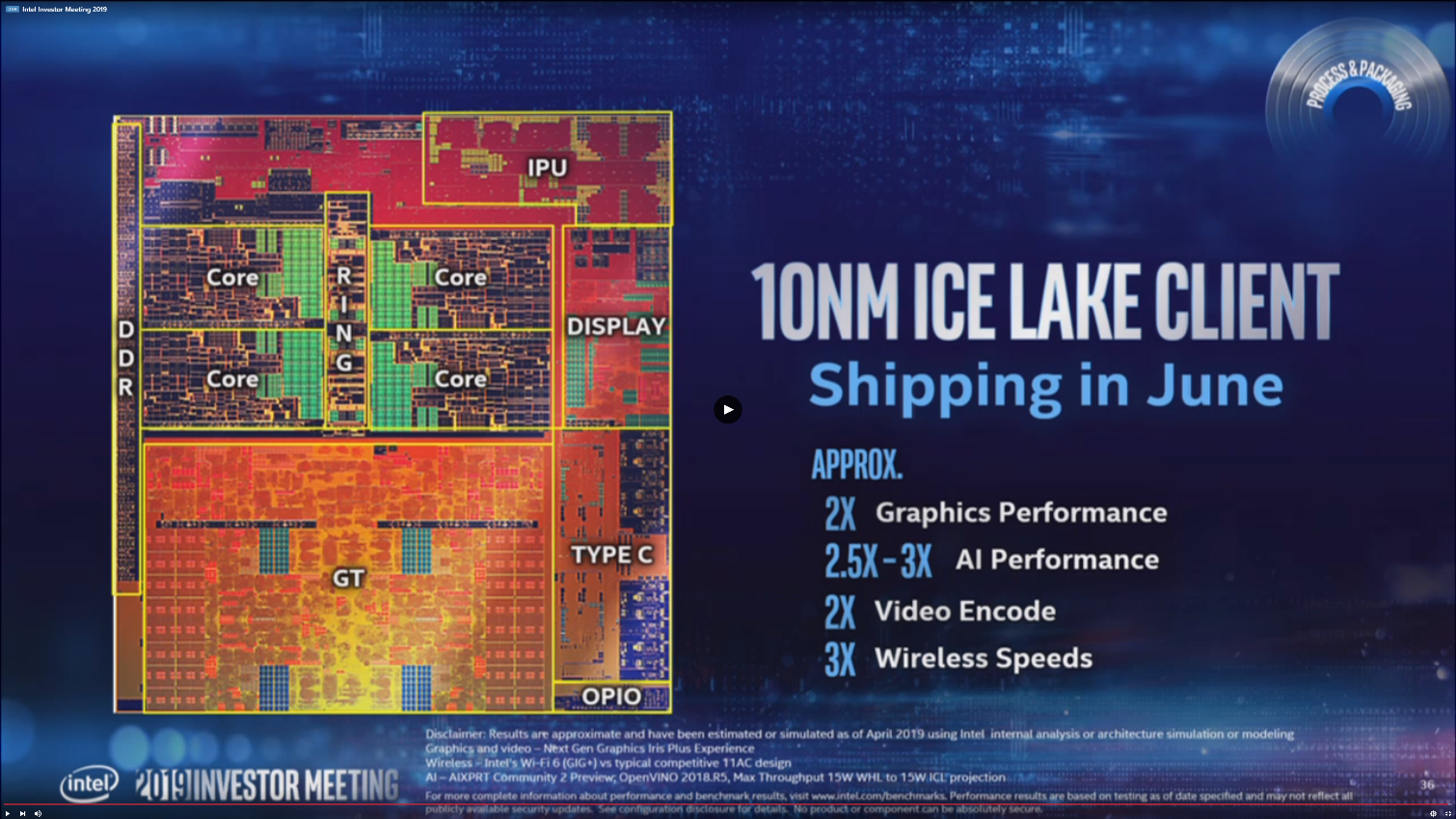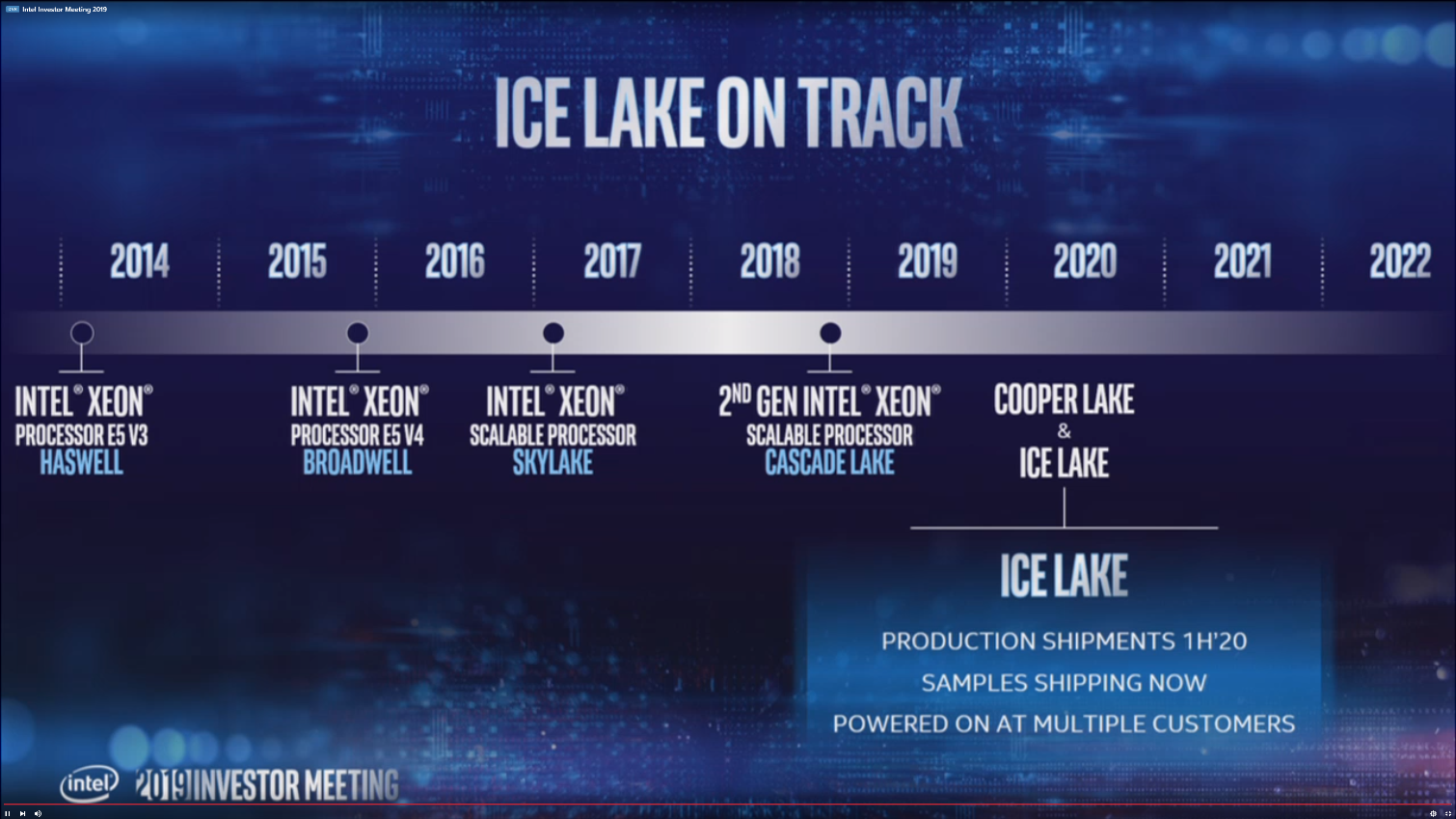Intel to Launch 7nm Process in 2021, 7nm Xe Graphics Architecture, Ice Lake Architecture
Intel held its 2019 investor meeting today, it's first since 2017, and CEO Bob Swan announced that Intel would launch its 7nm process in 2021 to challenge TSMC's 5nm products.
Intel's Xe graphics will be the leading 7nm product, which will come on the heels of Intel's first discrete 10nm GPU that arrives in 2020. The company also unveiled its first block diagram of the Ice Lake architecture and announced that its new 10nm Tiger Lake processors will come to market in 2020, which we covered here.
The Road to 7nm
Intel hasn't officially revealed a timeline for its 7nm process in the past, but Swan indicated that this fast-follow to the 10nm process reflects an acceleration of the production of the process node. That isn't entirely surprising given the difficulties the company has experienced with its long-overdue 10nm node that finally arrives in volume in June.
Intel also announced that an Xe GP-GPU (General-Purpose Graphics Processing Unit) for the data center would be the first 7nm product to come to market, arriving in 2021. The next 7nm processor from Intel will come in the form of a data center Xeon.
Swan indicated that the company's gross margins would contract as it adjusts its 10nm production and ramps 7nm. Intel's 7nm will be the company's first mass production of a process node using EUV (extreme ultraviolet) lithography technology, providing a 2X improvement in density compared to 10nm. It will also use EMIB and Foveros packaging heavily with its 7nm products. Intel also expects a 15% improvement in transistor performance and a 20% improvement in performance-per-watt.
Dr. Murthy Renduchalata dove in deeper on the difficulties that Intel encountered in its move to the 10nm process, such as taking on too much risk on 10nm design goals. The company plans to address this in the future by redefining expectations for process development. Intel also plans to focus on intra-node optimizations of its new nodes, meaning more "+++" steps for all of its future process technologies. In the future, Intel plans to deliver one Moore's Law gain at the beginning of each node, and another at the final revision of the node.
As you can see in the chart above, Intel will overlap its 10nm++ node and 7nm in 2021, with 7nm taking full center stage in 2022.
Get Tom's Hardware's best news and in-depth reviews, straight to your inbox.
The Xe Graphics Architecture - 7nm in 2021
Intel will use its EMIB (Embedded Multi-Die Interconnect Bridge) and 3D Foveros technologies for the Xe Graphics Architecture. Intel also revealed that the new GP-GPU design would power the exascale Aurora supercomputer. We have extensive coverage of Aurora here.
Intel's Dr. Murthy Renduchintala also unveiled a conceptual design of the company's new MCM (Multi-Chip Module) design (right) with several XPU chips, which indicates these are not CPUs, tied together with a fabric. Given Intel's reference to a heterogeneous architecture via EMIB for its Xe Graphics, this could be a potential render of the Xe Graphics Architecture. We're reaching out for confirmation.
10nm Ice Lake Emerges - Shipping In June
Intel also unveiled the first block diagram of its 10nm Ice Lake processors. We already know this design features the Sunny Cove core architecture. Intel says Ice Lake will feature 2X the graphics performance (courtesy of its Gen11 integrated graphics), 2.5X to 3.5X the AI performance, and 3X the wireless speeds of the Coffee Lake chips. As we can see, Intel is sticking with its ring bus architecture instead of migrating to its newer mesh design, and has an integrated USB Type-C controller on-die.
Intel will also release 10nm CPUs for client and server markets, 10nm AgileX FPGAs, 10nm Nervana NNP-I, a 10nm general purpose GPU, and the Snow Ridge 5G-ready SoC, all in 2019 and 2020.
Cooper Lake and Ice Lake for the Data Center
Intel will also ship 10nm servers in the first half of 2020. Intel announced that Ice Lake-SP data center processors are already shipping to leading customers, and that its 14nm Cooper Lake processors are on track for a 2020 delivery. The company says these new processors will come with more cores than the existing models. From a larger perspective, Intel is working to shorten its delays between server processor launches, to roughly one release every four to five quarters.
The Shortage, NAND, and Other Bits
Swan said that 14nm chip supply would continue to improve, with full availability expected by the fourth quarter. Intel also announced that it will not build any new NAND production capacity this year, but will deliver 96-layer NAND in the second half of the year. Intel is also exploring partnerships before it moves forward on the flash memory front. Intel has been rumored to be speaking with Tsinghua Unigroup, a Chinese-government backed corporation, as a potential NAND production partner.

Paul Alcorn is the Editor-in-Chief for Tom's Hardware US. He also writes news and reviews on CPUs, storage, and enterprise hardware.
-
Giroro I am very confused what "USB Type-C on-die " means.Reply
Isn't USB-Type C is a connector style, not really a version of USB. -
alextheblue Reply
Marketectural enhancements!Giroro said:I am very confused what "USB Type-C on-die " means.
Isn't USB-Type C is a connector style, not really a version of USB.
That aside, these ARE interesting times. -
valeman2012 Reply
Well they are smart stepping back on Moore Law and let AMD CPU Business hit dead end on Moore Law first.alextheblue said:Marketectural enhancements!
That aside, these ARE interesting times. -
alextheblue Reply
AMD hasn't been following Moore's Flaw for a while now, and neither has Intel. Just because TSMC is slightly ahead of Intel on process rollouts doesn't mean Intel is intentionally "stepping back". They had ISSUES with their 10nm (equivalent to TSMC's 7nm), it's LATE.valeman2012 said:Well they are smart stepping back on Moore Law and let AMD CPU Business hit dead end on Moore Law first.
I know you're a fan of Intel, and that's totally cool. They've put out some really nice processors over the years. But that doesn't change the truth, so I'll just repeat this one more time: Intel didn't PLAN on waiting until 2020 to mass rollout 10nm. They ran into technical problems. End of story. -
Karadjgne He's also a fan of large print. As if the standard 15point isn't loud enough to get the point across. Just to be fair.Reply
Moore's Law is dead. It was dumb to begin with. Stating that a cpu will double in speed and capability every 2 years simply due to the amount of transistors a die can field is rediculous.
By that reasoning, a current cpu would be operating at close to 13.6GHz as compared to a 6 year old FX at 3.4GHz and a fx8 has 1.2Billion transistors, an R7 2700 has 4.8Billion, so that math is wrong too. -
valeman2012 Replyalextheblue said:AMD hasn't been following Moore's Flaw for a while now, and neither has Intel. Just because TSMC is slightly ahead of Intel on process rollouts doesn't mean Intel is intentionally "stepping back". They had ISSUES with their 10nm (equivalent to TSMC's 7nm), it's LATE.
I know you're a fan of Intel, and that's totally cool. They've put out some really nice processors over the years. But that doesn't change the truth, so I'll just repeat this one more time: Intel didn't PLAN on waiting until 2020 to mass rollout 10nm. They ran into technical problems. End of story.alextheblue said:AMD hasn't been following Moore's Flaw for a while now, and neither has Intel. Just because TSMC is slightly ahead of Intel on process rollouts doesn't mean Intel is intentionally "stepping back". They had ISSUES with their 10nm (equivalent to TSMC's 7nm), it's LATE.
I know you're a fan of Intel, and that's totally cool. They've put out some really nice processors over the years. But that doesn't change the truth, so I'll just repeat this one more time: Intel didn't PLAN on waiting until 2020 to mass rollout 10nm. They ran into technical problems. End of story.
Not fan of any AMD or Intel...the only fans i see is AMD Fanboys getting upset over the truth.. (You look at other sites articles relating to AMD or Intel comments (Joking around or not joking around) ...see how AMD Fanboys get upset.
Just like many other games
I am fan of none but i am only going for product that would be "better" for Gaming right which is obviously intel...(If AMD was "better" i would went there ...its not really choice...mostly go for the "better" product. -
TJ Hooker Reply
Moore's law is about is transistor density. It says nothing about performance.Karadjgne said:Moore's Law is dead. It was dumb to begin with. Stating that a cpu will double in speed and capability every 2 years simply due to the amount of transistors a die can field is rediculous.
By that reasoning, a current cpu would be operating at close to 13.6GHz as compared to a 6 year old FX at 3.4GHz and a fx8 has 1.2Billion transistors, an R7 2700 has 4.8Billion, so that math is wrong too.
With regard to FX 83xx vs R7 2700, you're forgetting about die sizes. The 2700 has about 6 times the density, meaning density doubled about 2.5 times in 6 years rather than 3 times as predicted my Moore's law. Not too far off really, despite the slowing of node progression.
Edit: And Ryzen 3000 on 7 nm will be coming out soon (~7 years after FX 83xx), which may even bring things further in line with Moore's law. -
bit_user Reply
It was never forecast to go on, forever. In 1965, it was forecast for at least a decade. Then, in 1975, another (and at a slower rate; source: https://en.wikipedia.org/wiki/Moore%27s_law ). That doesn't make it dumb.Karadjgne said:Moore's Law is dead. It was dumb to begin with. Stating that a cpu will double in speed and capability every 2 years simply due to the amount of transistors a die can field is rediculous.
By that reasoning, a current cpu would be operating at close to 13.6GHz as compared to a 6 year old FX at 3.4GHz and a fx8 has 1.2Billion transistors, an R7 2700 has 4.8Billion, so that math is wrong too.
Also, you misunderstand the speed increases as relating directly to clock speed. Being able to pack more transistors on-die enabled various sorts of optimizations that could reduce the number of clock cycles per operation, and then increase the number of operations that can be performed concurrently. So, it was the combination of clock speed and efficiency which delivered the observed performance gains. -
bit_user Reply
Nomenclature aside, I assume the point was to support USB-connected displays.Giroro said:I am very confused what "USB Type-C on-die " means.
Isn't USB-Type C is a connector style, not really a version of USB. -
JaSoN_cRuZe If the rumors were true about AMD's Zen 2 chipsets, it would be a hard sell of Intel processors.Reply
I think by the time they release 10nm desktop parts, AMD would be sitting @ 5nm.
Intel better hustle.
